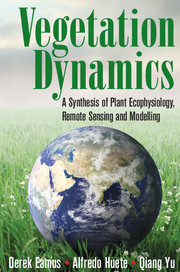Book contents
- Frontmatter
- Contents
- Preface
- Section One Plant Ecophysiology
- Section Two Remote Sensing
- Section Three Modelling
- Section Four Case Studies
- 14 Boreal Forests
- 15 Arid and Semi-Arid Grasslands
- 16 Savannas
- 17 Seasonal Behaviour of Vegetation of the Amazon Basin
- 18 Tropical Montane Cloud and Rainforests
- 19 Groundwater Dependent Ecosystems
- 20 Global-Change Drought and Forest Mortality
- Index
- References
16 - Savannas
from Section Four - Case Studies
Published online by Cambridge University Press: 05 June 2016
- Frontmatter
- Contents
- Preface
- Section One Plant Ecophysiology
- Section Two Remote Sensing
- Section Three Modelling
- Section Four Case Studies
- 14 Boreal Forests
- 15 Arid and Semi-Arid Grasslands
- 16 Savannas
- 17 Seasonal Behaviour of Vegetation of the Amazon Basin
- 18 Tropical Montane Cloud and Rainforests
- 19 Groundwater Dependent Ecosystems
- 20 Global-Change Drought and Forest Mortality
- Index
- References
Summary
Introduction
Savannas are biomes with a discontinuous tree layer and a grass understorey. They are generally tropical or sub-tropical with a distinctly seasonal distribution of rainfall. The two major plant functional types (trees and grasses) have contrasting strategies for surviving the dry season and this is reflected in the seasonality of productivity, leaf area index and patterns in water-use. Woody thickening, whereby the standing biomass of trees increases over time, is a globally observed phenomenon which has implications for carbon (C) storage and catchment water balances of savannas.
Key questions addressed in this case study include: How do tree and grass productivities vary at daily, seasonal and inter-annual time-scales? What are the major drivers of variability in C uptake and water-use at a single site and along rainfall gradients? What is causing woody thickening globally?
A range of field based studies at leaf, canopy and plot scales are discussed in this chapter to illustrate the relationships among meteorological variables at hourly, daily, seasonal and inter-annual time-scales. Remotely sensed data are used to examine: (a) the relative importance of various environmental drivers in explaining differences in productivity; and, (b) large spatial and temporal patterns in phenology along an aridity gradient in north Australia.
Variation in soil moisture content and vapour pressure deficit are vitally important as drivers of daily and seasonal patterns of water-use and C fluxes of savannas. Explanations for inter-annual variations in phenological patterns differ according to aridity and the relative dominance of monsoonal versus convective storm rainfall. Productivity of savannas is very strongly influenced by water availability and much of this is related to changes in LAI of the understorey.
What Are Savannas?
Savannas are characterised by: (i) a high degree of predictability in the occurrence of wet and dry seasons (although timing and amount of rainfall can vary and this can have important impacts on savanna function); (ii) moderate to high temperatures; (iii) the coexistence of a tree dominated overstorey and grass dominated understorey; (iv) the occurrence of fire as a frequent disturbance; and, (v) for tropical and sub-tropical savannas, only small variation in day length. This is contrast to Boreal forests Chapter 14), which are characterised by winters of extreme cold and short day length, and arid and semi-arid grasslands (Chapter 15), which are characterised by very low inputs of rain and extreme variability in the timing and amount of rainfall received each year.
- Type
- Chapter
- Information
- Vegetation DynamicsA Synthesis of Plant Ecophysiology, Remote Sensing and Modelling, pp. 383 - 414Publisher: Cambridge University PressPrint publication year: 2016



